Middleburg Interview with “Left-Handed Girl” Director Shih-Ching Tsou
Written by: Christopher Llewellyn Reed | October 30th, 2025
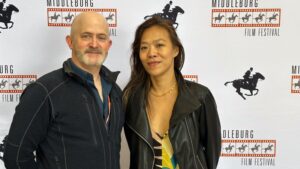
Filmmaker Shih-Ching Tsou is a longtime collaborator of Sean Baker’s. In her first helming effort, the 2004 Take Out, she shared directorial duties with Baker. Since then, Tsou has produced many of his later films, including the 2021 Red Rocket. She and Baker co-wrote the screenplay for Left-Handed Girl, though Tsou is the sole director on it. The movie follows a family of three—mom, a teenage girl, and a much-younger daughter (a southpaw, hence the title)—as they return to Taiwan’s capital of Taipei after years away to try and make a go of running a noodle stand in a night market. The movie examines generational differences, societal prejudice, and other universal issues, all of it in a poignant, simultaneously funny and dramatic manner. I had a chance to speak in person with Tsou at the recent Middleburg Film Festival (where I reviewed the film), and here is that conversation, edited for length and clarity.
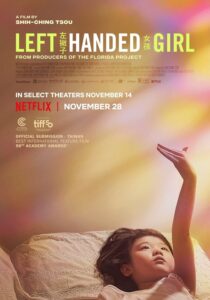 Christopher Llewellyn Reed: It’s been a while since you stepped behind the camera to direct. The last time was in 2004, for Take Out, which you co-directed with your longtime collaborator Sean Baker, for whom you later produced many films. What made this the right time to direct again?
Christopher Llewellyn Reed: It’s been a while since you stepped behind the camera to direct. The last time was in 2004, for Take Out, which you co-directed with your longtime collaborator Sean Baker, for whom you later produced many films. What made this the right time to direct again?
Shih-Ching Tsou: Well, this idea was actually the very first idea I brought to him when I first met him. I told him about what my grandfather told me in high school, “the left hand is the devil’s hand.” He asked me not to use it. I got corrected very early on. So when I met him in New York, I told him and he thought, “This sounds like a very good idea; we can spin it into a script.” So we started to try to make it and went to Taiwan.
He had never been to Taiwan before. I showed him the night market. And he immediately said, “Wow, all those elements are so cinematic and would look so good on screen.” And also it was Taiwanese talking about Taiwanese and we wanted to make something that was really authentic. But then we realized that this was too big an idea for us to start with. So we went back to New York to make Take Out together. In 2010, we went back to Taiwan again, determined to make Left-Handed Girl but still couldn’t find the money. Eventually, in 2022, we showed the script to the French distributor of Red Rocket when we went to the main competition in Cannes.
They really liked the story and said that if we could get a Taiwanese government film fund they would help us make the movie. So I think the whole story comes down to just the timing. At the time, early 2000s, not many people really cared about Asian cinema, especially in the U.S. People don’t like to watch movies with subtitles. It wasn’t until Parasite won the Oscar that it opened people’s eyes. Producers pay attention to those local stories, the small movies that really make a big impact. Plus, Sean won four Oscars this year. I think that really also helped people pay attention to why he’s doing this. And I think everything just came together.
CLR: Who knew that K-Dramas would be the way that Americans would start liking subtitles, right? Not just because of Parasite. It’s also things like Squid Game. So it seems it’s the Koreans who are teaching Americans to like subtitles. You just brought up how you were corrected, as a child, from doing things with your left hand. How does that work? Your brain is still sending signals to the left hand, right?
S-CT: Well, it’s very instinctual. You can’t really change something like that. For example, when I pick something up, I just use my left hand. My brain tells me to use my left hand. So I think a lot of left-handed people who are corrected in this way end up becoming ambidextrous. A lot of people get corrected and that creates some other problem for them. I have heard that some people stutter as a result. They couldn’t speak right because they got corrected; everybody has a different kind of situation.

CLR: So the origin of the story begins with personal experiences, but then you layered other things on it, correct?
S-CT: I grew up in Taiwan, so I know everything inside out. And I think that’s part of the reason I wanted to leave Taiwan for another country because I wanted to try something different. Growing up in Taiwan as a woman has limitations, with a lot of expectations on us. So a lot of times you cannot speak up, you cannot be different. There’s a lot of conformity. I have naturally darker skin, so when I was young, up until even now, my mom would be like, “Don’t get tan, put on long sleeves.” So there are 20 years of me putting together all the stories. I talk to my friends who still live in Taiwan, so it’s kind of everything come together.
CLR: You shot this film on an iPhone, but whenever people say they shot a film on an iPhone, they’re not talking about just the device [holds up iPhone] because you trick it out a little bit more. What are the accessories you used and the ways you tricked out this iPhone? I know it was a 4K iPhone.
S-CT: At the time, we had the latest phone, which was the iPhone 13 Pro Max. And we got four phones from Apple and we also used the Filmic Pro app, which was the same app we used for Tangerine. And obviously now everything is so much more advanced, we can shoot in 4K Lux mode. So when the footage comes out it’s a little bit washed out, but you can do a lot with it. It’s basically like RAW format. It gave us a lot of freedom in post. We did Blackmagic color correction. We also used a Beastgrip. This is a company that produces a very professional iPhone case. And they also have an anamorphic lens. I got it from them as a prototype at the time; it’s really new. So, they gave us that lens and there’s a “black forest” filter so when you hit the light, it has that blurry kind of look, like a dreamy look. And then we also used three different stabilizers.
CLR: Well, it looks great. And you worked with two cinematographers. What sort of instructions did you give them, beyond all these accessories on the iPhone, in terms of the look you wanted for the movie?
S-CT: We had a very extensive meeting with the main photographer and sat down for three or four days, just breaking down the script. We broke down every scene and we talked about how this is seen through a little girl’s eyes. We had to stay low angle, especially in the night market when she’s running around. We wanted the audience to see everything through her eyes and through her angle, to keep a very immersive kind of feeling. We also did a lot with the color in post.
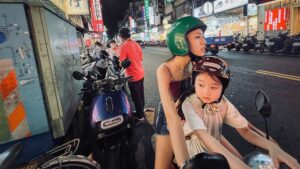
CLR: Speaking of shooting in the night market with the low angle, were there moments—because your rig was so small—when you could just film and not have to control traffic, where you’re just following her without doing anything and you get free extras because they’re there? Or did you have to stage some of that when you were following her?
S-CT: Well, that’s the trick. That’s the reason we wanted to use the iPhone because I wanted to capture that real night-market vibe. We never, ever controlled anything. We let people walk around; we let people go through our frame because we wanted that authentic feeling of the vibe of the night market. And all the extras, they’re all real people in the night market.
CLR: Did you have to put something up that says, “If you’re here, you’re on camera”?
S-CT: Yes, but also we were there for so long, so almost every other stand knew what we’re doing. We actually had a very supportive community in that night market.
CLR: Where did the meerkat come from? I didn’t even know that people kept them as pets.
S-CT: That’s a funny thing. In the script, from 2010 forward, everything stayed the same: the story arc and the beginning, middle, and end. The meerkat is the only thing that got changed because in the original script, GooGoo was actually a monkey. I had a pet monkey when I was young, so I wanted to have a monkey in the film. During pre-production, I asked my line producer to find a monkey. She’s aboriginal, so she has a lot of family and friends living on a mountain. So she actually went to the mountain and found this little monkey. And she FaceTimed me from the mountain and said, “What do you think about this monkey?” And I was like, “OK, yeah, we found a monkey!”
But then later on I found out we can’t really use a monkey because they have really strict rules in Taiwan. You need to have a trainer; you need to have a professional certificate for the monkey to be in the film. And at the time it was still the pandemic. So we couldn’t import a monkey trainer from Thailand—there are a lot of performing monkeys in Thailand—and ask the trainer to quarantine for 21 days. I thought everybody would go crazy. So we couldn’t do that.
So I went to a vet in Taiwan who had a couple of exotic animals. At the time he had a white fox and also this meerkat. And he said the meerkat is really, really smart: he lives at home with other dogs and cats and he’s like a little king at home because he’s so smart. He basically just rules over all the animals. So we decided to use him. We had this ball and put a little cockroach inside. So you threw the ball and the meerkat knew there was a cockroach in it and chased the cockroach.
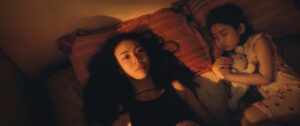
CLR: What is the scam that the grandmother is doing? I was trying to figure out what she’s doing with those passports and those people that she brings to her apartment.
S-CT: This is actually inspired by a real news story, which is in the film. That’s the real news I purchased from a TV station because we saw the news and at the time they used a grandmother. It’s a decoy for a lot of illegal immigrants coming from China. They want to go to the U.S. so they come to Taiwan first, use a fake passport and then are accompanied by this grandmother so people don’t get suspicious. “It’s just a grandmother with a young girl.” That’s the scheme.
CLR: How did you cast the film?
S-CT: Working with Sean Baker, we developed this method of how to cast people on the street and how to shoot in real locations. I was determined to find my own star for the film. So when I was trying to find a little girl, we had a social-media street casting. I watched 50 to 70 audition tapes and I couldn’t find her. But eventually, she got recommended by an agent of an actor in Taiwan. And at the time, Nina had already acted in so many commercials; she had done them since she was 3. And when I cast her, she was 6. Her mother took her to all the auditions and also coached her on the side. When I cast Nina, I was so surprised: she’s such a little girl, but she has such charisma. She knows what to do in front of camera. And she’s very, very professional. She’ll come to set and her mom will help her memorize the lines; she didn’t read Chinese at the time. Sometimes she was able to improvise her own words and put her own spin on different scenes.
And Shih-Yuan Ma, I actually found on Instagram because I couldn’t stay in Taiwan for a long period of time to do a real street casting. So I thought, “Well, Instagram would be perfect.” I was looking for a Taiwanese girl, or Taiwanese models, just looking through all the profiles. It got to the point where my husband asked me, “What are you doing looking for young girls on Instagram? What’s wrong with you?” (laughs) And then I told him, “I’m casting!” So when I saw her photo I immediately knew she’s the one because she had that aura, very rebellious. She is a natural-born talent; I think she had only taken one acting class at the time, but she’s perfect.
And then Janel Tsai, she’s a famous model and also a TV actress in Taiwan. And I think at the time she had just won the Best Supporting Actor Emmy in Taiwan. I saw one of her interviews where she was talking about how she wanted to take on some different roles or different challenges. So I just took that opportunity to reach out to her and she’s perfect.
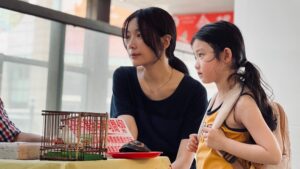
CLR: And how about Brando Huang?
S-CT: I knew him before and when I was thinking about this role, I told my line producer that he was the right person to play Johnny. So we had to just reach out to him. I didn’t even write his lines because I know how good he is. He’s a very famous comedian. He’s also like a TV host, so he’s really good at improvising. I didn’t need to do anything. I said, “This is yours; you can do your thing. I completely trust you.”
CLR: Thank you so much!
S-CT: Thank you!

